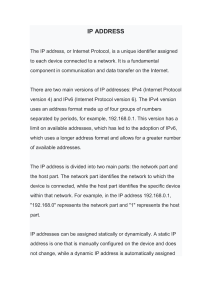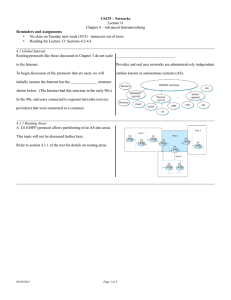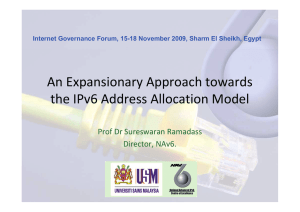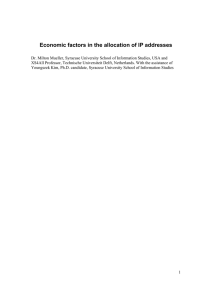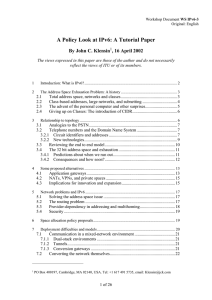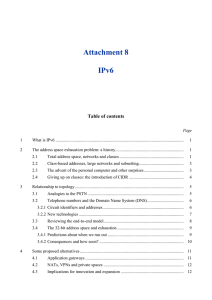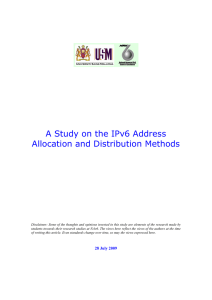Contribution towards a clear understanding of IPv6 and IPv4 issues
advertisement
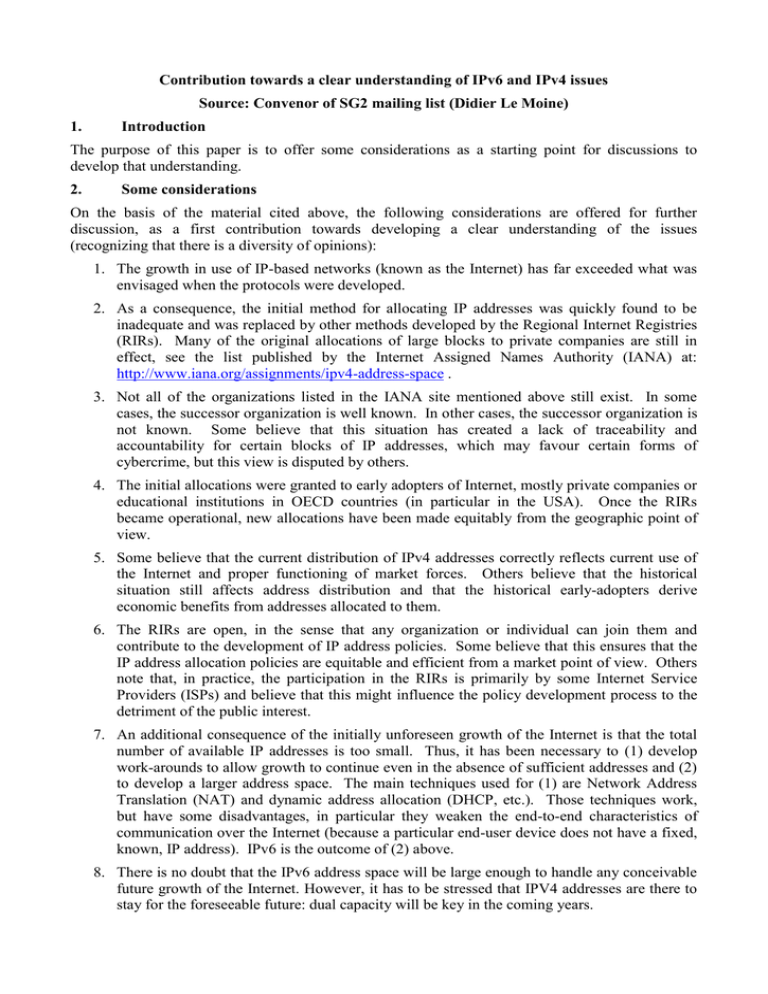
Contribution towards a clear understanding of IPv6 and IPv4 issues Source: Convenor of SG2 mailing list (Didier Le Moine) 1. Introduction The purpose of this paper is to offer some considerations as a starting point for discussions to develop that understanding. 2. Some considerations On the basis of the material cited above, the following considerations are offered for further discussion, as a first contribution towards developing a clear understanding of the issues (recognizing that there is a diversity of opinions): 1. The growth in use of IP-based networks (known as the Internet) has far exceeded what was envisaged when the protocols were developed. 2. As a consequence, the initial method for allocating IP addresses was quickly found to be inadequate and was replaced by other methods developed by the Regional Internet Registries (RIRs). Many of the original allocations of large blocks to private companies are still in effect, see the list published by the Internet Assigned Names Authority (IANA) at: http://www.iana.org/assignments/ipv4-address-space . 3. Not all of the organizations listed in the IANA site mentioned above still exist. In some cases, the successor organization is well known. In other cases, the successor organization is not known. Some believe that this situation has created a lack of traceability and accountability for certain blocks of IP addresses, which may favour certain forms of cybercrime, but this view is disputed by others. 4. The initial allocations were granted to early adopters of Internet, mostly private companies or educational institutions in OECD countries (in particular in the USA). Once the RIRs became operational, new allocations have been made equitably from the geographic point of view. 5. Some believe that the current distribution of IPv4 addresses correctly reflects current use of the Internet and proper functioning of market forces. Others believe that the historical situation still affects address distribution and that the historical early-adopters derive economic benefits from addresses allocated to them. 6. The RIRs are open, in the sense that any organization or individual can join them and contribute to the development of IP address policies. Some believe that this ensures that the IP address allocation policies are equitable and efficient from a market point of view. Others note that, in practice, the participation in the RIRs is primarily by some Internet Service Providers (ISPs) and believe that this might influence the policy development process to the detriment of the public interest. 7. An additional consequence of the initially unforeseen growth of the Internet is that the total number of available IP addresses is too small. Thus, it has been necessary to (1) develop work-arounds to allow growth to continue even in the absence of sufficient addresses and (2) to develop a larger address space. The main techniques used for (1) are Network Address Translation (NAT) and dynamic address allocation (DHCP, etc.). Those techniques work, but have some disadvantages, in particular they weaken the end-to-end characteristics of communication over the Internet (because a particular end-user device does not have a fixed, known, IP address). IPv6 is the outcome of (2) above. 8. There is no doubt that the IPv6 address space will be large enough to handle any conceivable future growth of the Internet. However, it has to be stressed that IPV4 addresses are there to stay for the foreseeable future: dual capacity will be key in the coming years. 9. There is general consensus that migration from IPv4 to IPv6 has been slower than hoped. Some believe that there is nothing wrong with this: market forces are working and are driving the transition at the economically optimum rate. Others disagree, stating that the migration involves network externalities, and that the individual economic actors responsible for the migration (network operators and Internet Service Providers (ISPs)) see only the costs of the migration (capital expenses, training, reconfiguration, user support, etc.) but no benefits. 10. The RIRs have developed procedures for the allocation of IPv6 addresses that are geographically equitable. Some believe that these procedures will work well for IPv6. Others fear that the procedures will replicate, at least to some extent, some of the current problems with IPv4 allocations. 11. In particular, questions persist regarding growth of routing tables. To date, the growth rate of the capabilities of routing hardware and software has been at least equal to the growth rate of the complexity of the Internet routing topology. That is, routers have been able to cope with the increase in routing table size. Some believe that this situation will persist, and that no new issues will arise with the deployment of IPv6. Others believe that routing table growth could become excessive when IPv6 is deployed and that measures should be taken to limit the growth of routing tables. Further, some have stated that large routing tables impose additional costs on developing countries, who must purchase powerful (and relatively more expensive) routers because of the size of the current routing tables. 12. Various methods have been proposed to limit the growth of routing tables, but there is no consensus regarding the validity or value of any of those methods. Indeed, as noted above, there isn’t even consensus regarding whether or not routing table growth is an issue of concern. __________
